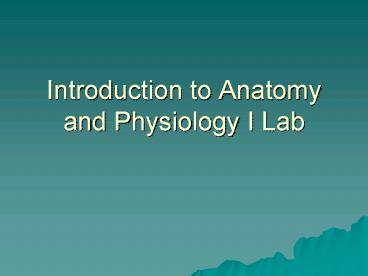Introduction to Anatomy and Physiology I Lab - PowerPoint PPT Presentation
1 / 24
Title:
Introduction to Anatomy and Physiology I Lab
Description:
Introduction to Anatomy and Physiology I Lab. Biol 1151L Anatomy and Physiology Lab I ... Get together with others to discuss and clarify concepts. ... – PowerPoint PPT presentation
Number of Views:103
Avg rating:3.0/5.0
Title: Introduction to Anatomy and Physiology I Lab
1
Introduction to Anatomy and Physiology I Lab
2
Biol 1151L Anatomy and Physiology Lab I
Barbara Musolf Office Arts and Science
G-110G E-mail BarbaraMusolf_at_clayton.com Web
site http//a-s.clayton.edu/bmusolf/ Phone
(678) 466-4851
Office hours Wednesday 900AM-1200PM
100-600PM And by appointment
3
Syllabus
- How much does attendance count?
- What happens if you arrive late to lab?
- What is the policy for makeup exams?
- Can you turn in assignments late? What happens
if they are late? - What is the policy towards cheating or
plagiarism? - Are the exam dates firm?
- What are the policies for withdrawing from the
course?
4
What you can expect
- Learning anatomy requires much memorization.
- Learning physiology exposes you to new concepts,
some of which require practice and perseverance
to understand. - This lab course provides a foundation for further
studies in health sciences.
5
Strategies
- Prepare for the lab before coming to class.
- Make sure you bring what is required to lab.
- Get together with others to discuss and clarify
concepts. - Study at least 2 times a day everyday to memorize
anatomy.
6
Communication
- Make sure you have an activated e-mail account.
- Know how to find assignments and course
information on my web site. - Visit me during office hours if you have any
questions.
7
Your Responsibilities
- Attend all labs and arrive on time.
- Be prepared for lab. Class should be the second
time you have encountered the material. - Finish lab assignments on time.
- Be prepared for the lab practical.
- Ask questions if something isnt clear.
- If you need any special accommodations, talk to
me now, so we can make the necessary
arrangements.
8
My responsibilities
- Grade assignments in a timely manner.
- Provide supplements to lecture
- Class web page will contain links to sites that
may help you review the information - Be available for help outside class.
- Office hours, e-mail, appointments.
9
Grading
- 3 Lab practicals (50 pts each) 150
- Class assignments 50
- Attendance
20 - Total 220
- A gt 197
- B 176 197
- C 154 175
- D 132 153
- F lt 132
10
Topics covered in 1151L
- Overview of the rat organ systems
- Cellular transport
- Histology
- Axial and Appendicular skeletal system
- Muscular physiology
- Muscle anatomy
- Nervous system physiology
- Central Nervous System anatomy and organization
11
Topics covered today
- How to use your A.D.A.M. software.
- Introduction to the microscope
- Parts of a microscope
- How to care for a microscope
- How to focus a microscope
- Introduction to histology
- Simple squamous epithelium
- Bone
- Skeletal muscle
- Nervous tissue
12
Parts of a microscope
- Eyepiece
- Body tube
- Arm
- Stage
- Base
- Light
- Power source
13
Parts of a microscope Nosepiece and objectives
14
Parts of a microscope Stage elements
15
Parts of a microscope coarse and fine focus
16
Care of microscope
- To carry a microscope, one hand grabs the arm and
the other hand supports the bottom of the base. - Never touch the lens with your fingers. The oil
from your hands can etch the glass. - Only clean the lens with lens paper. Other paper
has fiber that can scratch the lens. - When you finish using your microscope rotate to
the lowest power objective (4X) and roll the
nosepiece so that the space between the stage and
nosepiece is reduced.
17
Focusing a microscope
- Turn the coarse adjustment knob to raise the eye
tube. - Rotate the nose piece until the 4X objective
clicks into place. - Adjust the diaphragm. Look through the eyepiece
and adjust until you see a white circle of light. - Place the slide on the stage. Gently slide the
slide clips in place. - Center the specimen over the aperture.
18
Focusing a microscope
- Looking from the side, lower the eye tube using
the coarse knob until the objective almost
touches the slide. - Looking through the eyepiece, VERY SLOWLY rotate
the coarse adjustment knob until the specimen
comes into focus. - Switch to a higher power objective and repeat
step 6 and 7. - Look through the eyepiece and use the fine
adjustment knob to focus the specimen.
19
Magnification and resolution
- Magnification is the enlargement of a specimen.
To determine magnification you take the power of
the eyepiece X the power of the objective. - Example A 10X eyepiece and a 4X objective
magnifies the specimen 40X. - Resolution is the amount of detail you can see.
This is limited by the wavelength of light that
illuminates the specimen.
20
Simple squamous epithelium
21
Simple squamous epithelium
22
Bone
23
Skeletal muscle
24
Nervous tissue































